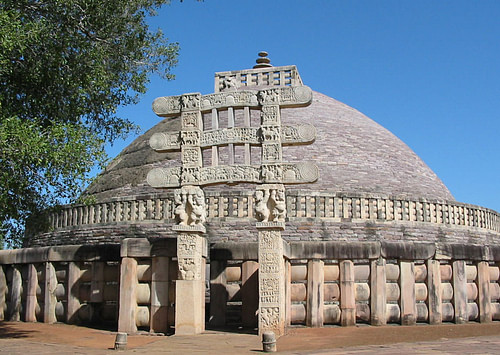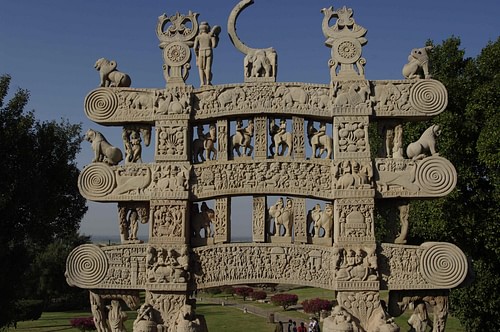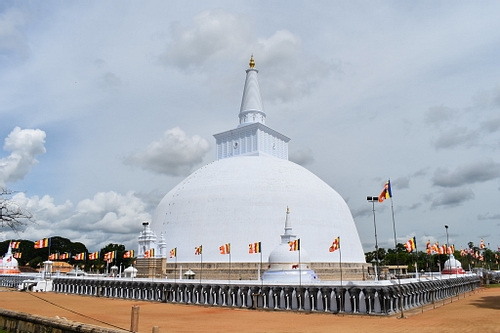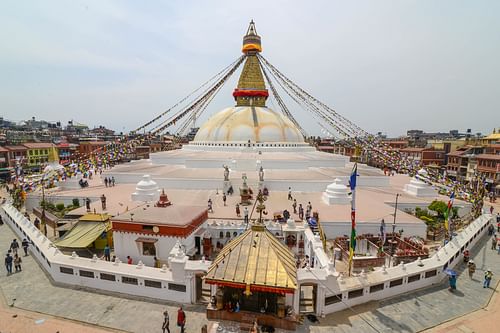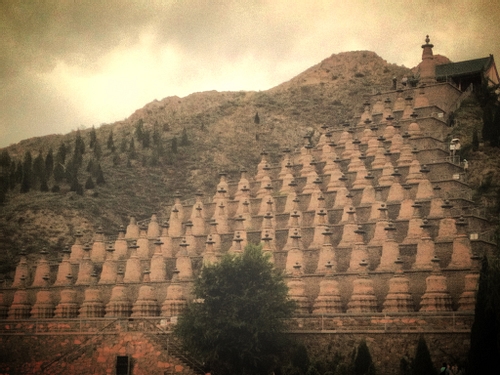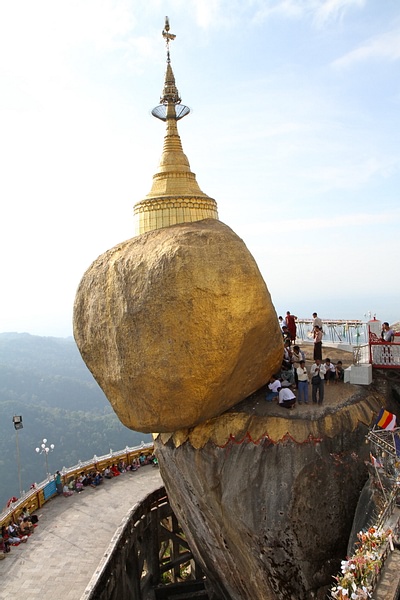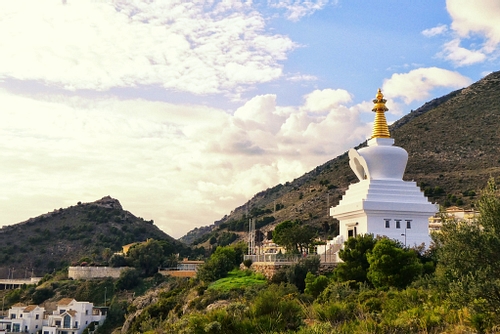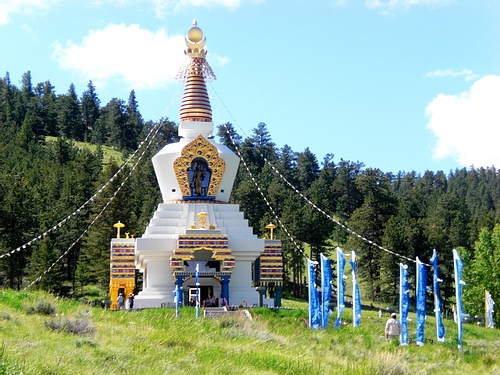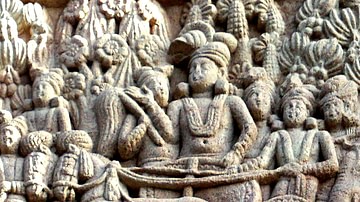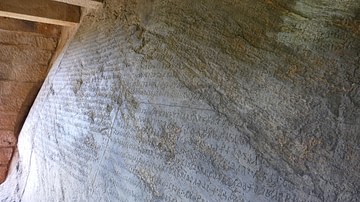A stupa is a reliquary containing the remains (relics) of an individual associated with great spiritual power and insight, most often (since the 3rd century BCE) with the Buddha (l. c. 563 - c. 483 BCE). The form, a hemisphere topped by a spire and surrounded by a gate and walkway, originated in India during the reign of the Mauryan king Ashoka the Great (268-232 BCE). Prior to the time of the Buddha, stupas were associated with ascetics, saints, or teachers of Hinduism but the Buddha requested that, when he died, his ashes be interred in a stupa located at a crossroads. His followers, instead, divided his remains and built eight (or ten) stupas in various places throughout India corresponding to important events in Buddha's life.
When Ashoka converted to Buddhism shortly after c. 260 BCE, he had the Buddha's remains taken from these stupas and decreed that thousands more be constructed throughout his empire (84,000 of them, according to legend), each to contain a small amount of the sacred relics. A stupa – one associated with Buddhism at least – must house some relic associated with the Buddha (or the person it is dedicated to) in order for it to be spiritually energized. Ashoka's vision was to fill his land with the Buddha's energy, which would then influence and elevate the lives of his people.
As part of his initiative in spreading Buddhist thought, he sent missionaries to other countries who carried with them the concept of the stupa and, presumably, some relic of the Buddha to consecrate the structure. The first country to embrace the new faith was Sri Lanka, but Buddhism spread also to China, Korea, Japan, Thailand, and across South Asia. In time, stupas were erected in these regions and, in the past 100 years, in western nations as well. Presently, there are thousands of stupas all around the world (precisely how many is unknown) which serve not only as sacred sites for worship and meditation but are also thought to emanate positive energies which help to elevate the lives of those who visit them and, by extension, all those whom the visitors then interact with.
A stupa may take the famous form of the hemispherical mound on a base standing alone or be coupled with a spired temple complex, a monastery, a learning center, religious retreat center, or religious community and assume other shapes. Stupas have been constructed in all sizes and from all kinds of different materials (even ice, in Ladakh, India) but the one constant is the deep, spiritual energy and positive benefits that Buddhists, and others, report experiencing from visits to them.
The following are ten of the best-known or most interesting stupas in the world:
- Sanchi Stupa - India
- Ruwanwelisaya – Sri Lanka
- Boudhanath Stupa - Nepal
- Swayambhunath Stupa – Nepal
- Borobudur – Java
- The One Hundred and Eight Stupas – China
- Kyaiktiyo Pagoda – (Golden Rock Stupa) – Myanmar
- Benalmadena Stupa - Spain
- The Great Stupa of Dharmakaya Which Liberates Upon Seeing – USA
- The Great Stupa of Universal Compassion – Australia
There are many others which should also be included in a list of great stupas, especially beautiful, modest structures such as the Shanti Stupa of Leh Ladakh, but time and space do not allow for their inclusion here.
Sanchi Stupa
The oldest stupa in India, and possibly in the world, construction of the Great Stupa at Sanchi was decreed and overseen by Ashoka the Great. It stands 54 feet (17 m) high and 120 feet (37 m) wide with a spire (yashti) at the top of the dome (known as the anda) surrounded by a railing (harmika). The base of the dome is encircled by a walkway visitors and pilgrims use in a ritual circumambulation clockwise around the stupa as prayers and mantras are recited. As with all stupas, visitors move clockwise around it to symbolically trace the path of the sun, giver of life, which sustains the natural order; moving counterclockwise around the stupa is to resist the positive energies of life, change, and transformation.
The stupa is enclosed by a wall with four gates (toranas) corresponding to the cardinal points and four central events in the Buddha's life (birth, enlightenment, first sermon, death/nirvana). The gates are highly ornamented with various figures suggesting Buddha's life (though he is not featured in physical form) as well as local deities. The stupa is part of a larger complex of other stupas, temples, and buildings. It was seriously damaged (or partially destroyed, according to some accounts) by the first monarch of the Shunga Empire (which succeeded the Mauryan Empire), Pushyamitra Shunga (r. 185 - c. 149 BCE), who resented Ashoka's fame and rejected Buddhism. Whatever damage was done to the stupa was repaired by Shunga's son, Agnimitra (r. 149-141 BCE), who also renovated the structure. It was abandoned at some point and forgotten until the 19th century CE when it was rediscovered and excavated; restoration began in the early 20th century CE. It remains one of the most popular pilgrimage sites and tourist attractions in India.
Ruwanwelisaya
Ruwanwelisaya Stupa is the most famous Buddhist shrine in Sri Lanka and among the most highly venerated in the world as it contains the greatest amount of the Buddha's relics and so is thought to resonate with significant spiritual energy. It stands 338 feet (103 m) high and 951 feet (290 m) wide at the base, making it one of the largest and tallest religious monuments in the world. The stupa was consecrated c. 140 BCE by King Dutugemunu (r. 161-137 BCE) who, among his other accomplishments, is remembered for his extensive building projects. The original stupa was built to house the sacred relic of the Buddha's begging bowl and began with a foundation of crushed stone which was flattened into the earth by elephants wearing leather boots to protect their feet and encourage uniformity of the stones; elephants are therefore honored at the site through statuary. The stupa sits in the center of a square, walled courtyard with four gates and four smaller stupas at each corner. The original structure of Dutugemunu has been renovated and enlarged over the centuries as part of the regular care and attention given to stupas generally.
Boudhanath Stupa
The great stupa of Boudhanath in Kathmandu is one of the largest in Nepal and a major pilgrimage site as well as tourist attraction. Its history is vague as its origins are clearly mythological and different traditions give its date of construction and consecration in different eras and under vastly different circumstances. It is thought to have been built in the late 6th century CE by a king of the Nepalese Licchavi Kingdom and was enlarged and expanded upon later, most likely in the 14th century CE. It has received greater attention since Tibetan refugees have found a home in the area and it is from these communities that varying histories of the site are given. The stupa rises 118 feet (36 m) high with a circumference of 328 feet (100 m). As with all stupas, the architecture is symbolically significant as the base, dome, harmika, spire, and pinnacle represent the five elements and the entire composition is a microcosm of the universe. The structure was damaged in an earthquake in 2015 CE and restored at a cost of over 2,000,000 US dollars. This stupa is frequently depicted in images on the subject for the dramatic spire with the large eyes of the Buddha painted on it facing in all four directions.
Swayambhunath Stupa
Swayambhunath Stupa in Kathmandu (also given as Svayambhunath, Swoyambhu) also has mythological origins as suggested by the name which means “self-created”. According to legend, a Lotus grew on the surface of a large lake which was mystically drained by the bodhisattva Manjushri; the valley which had been the lakebed then became fertile farmland for the people, and the Lotus flower transformed into the stupa. Once the stupa had unfolded itself, four beings of bright, positive, energies took up residence and continue to live there, helping to keep the earth in balance and harmony. The site is often alluded to as the “Monkey Temple” for the monkeys that live around it who are thought to be descendants from the monkeys who transformed from the head lice of Manjushri. The theme of transformation, clearly, is an important aspect of this stupa. Transformation, change, accepting and moving with the natural flow of existence, is an integral aspect of all stupas but Swayambhunath emphasizes this concept more directly than many others.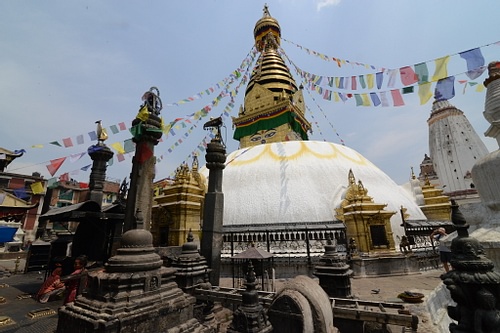
Historically, it was most likely built in the 5th century CE at a site already consecrated to the Buddha by Ashoka the Great in the 3rd century BCE and then enlarged and expanded upon later. It rises from a hill which is thought to have been the mystical hillock that Manjushri was building (or adding to) when he drained the lake. The stupa is 131 feet (40 m) tall and 328 feet (100 m) in circumference with 365 steps leading up to its entrance. The site is sacred to both Buddhists and Hindus who participate in rituals conducted there. It was damaged in the same 2015 CE earthquake that struck Boudhanath and was also repaired at significant expense which was met by Buddhist and Hindu communities from around the world.
Borobudur
Borobudur is the largest Buddhist temple in the world and the most famous monument in Central Java, Indonesia. The structure takes the form of a step pyramid featuring 72 small stupas on the uppermost level but is itself an enormous stupa, highly ornamented with thousands of reliefs and statues, including 504 statues of the Buddha. Construction took place in the 8th and 9th centuries CE, but there are no records regarding its founding or consecration. The stupa is 95 feet (29 m) high and covers an expanse of 29,910 square feet. Borobudur was an important pilgrimage site from its completion up through the 15th century CE when it was abandoned for unknown reasons. It was rediscovered in the 19th century CE and excavated in the early 20th century. Today it is a UNESCO world heritage site.
The One Hundred and Eight Stupas
The monument of The One Hundred and Eight Stupas (also known as the 108 Pagodas) is another impressive Buddhist monument and a major pilgrimage/tourist site in Ningxia, China. It was begun during the time of the Western Xia Kingdom (1038-1227 CE) with construction continuing afterwards, and additions made at different times by succeeding states. The structure is 104 feet (31 m) tall and 177 feet (54 m) at the base, rising 12 levels from base to top and featuring 108 stupas. The number 108 is sacred in Buddhism (and Hinduism as well) as it represents various aspects of the human condition but, primarily wholeness. The site was never abandoned but fell into disrepair and was renovated and refurbished in the 1980s CE when it began to be promoted as a tourist attraction.
Kyaiktiyo Pagoda
The Kyaiktiyo Pagoda (also known as Golden Rock Stupa) is one of the most unusual in the world. It is a 24-foot-high (7.3 m) stupa built on a boulder 25 feet (7 m) high and 50 feet (15 m) in circumference on the edge of a cliff 3,600 feet (1,100 m) above sea level in the Eastern Yoma Mountains of Myanmar. The stupa was built in 574 BCE, but its origins are obscured by legend. According to the traditional account, a hermit carried a single hair of the Buddha, which he kept on his own head, and was searching for a site on which to build a stupa when he found the boulder on the edge of the cliff which he felt looked like his head. This legend gives the site its name in the Mon language which translates as “to carry on the hermit's head”. The hair of the Buddha, which was placed beneath the boulder, is said to be the only reason the stone and stupa remain in place. As with the other stupas, it is a popular tourist and pilgrimage destination, but women are not allowed to approach the boulder or the stairway leading up to the stupa, though they may view it and pay their respects from a short distance away from the walkway and complex surrounding the site. The gold of the site is reapplied by male priests and pilgrims as a devotional act.
Benalmadena Stupa
The Benalmadena Stupa in Andalusia, Spain is the tallest stupa in Europe at 108 feet (33 m) high. Consecrated in 2003 CE, the stupa is unique in that, unlike most stupas whose interiors are sealed and contain relics, this one is open to the public for meditation and prayer. Its location is also of particular interest in that it is situated close by the well-known Benalmadena resort strip which is a popular tourist destination. The stupa's location emphasizes the integration of Buddhist principles with one's daily life and activities. The sacred space of the stupa does not stand in contrast to the secular life at the resorts but welcomes everyone to an inclusive place of reflection, regeneration, and renewal.
Great Stupa of Dharmakaya Which Liberates Upon Seeing
This stupa is the tallest in North America, rising to the same height as the Benalmadena Stupa at 108 feet (33 m) at the site of the Shambhala Mountain Center in Red Feather Lakes, Colorado, USA. Its purpose also mirrors that of the Benalmadena Stupa as a symbol and beacon of world peace. It was commissioned in 1988 CE following the death of the Buddhist master Chogyam Trungpa Rinpoche, founder of the center, whose remains are interred in the base and walls along with relics of the Buddha and other sacred objects. It was consecrated in 2001 CE, rises three levels, and is surrounded by 13 spires, symbolizing the 13 levels of enlightenment. It is also, like Benalmadena, an open stupa with a meditation center in the interior whose focal point is a gold statue of the Buddha.
The Great Stupa of Universal Compassion
The Great Stupa of Universal Compassion was conceived as an exact replica of the Great Gyantse Stupa (known as Kumbum) in Gyantse, Tibet, consecrated in 1497 CE. Like the original structure, the great stupa in Victoria (Bendigo), Australia is designed to reflect the Buddhist cosmos while also serving as a retreat center and symbol of world peace, compassion, and understanding. It is 164 feet (50 m) tall and 164 square feet at its base, making it the largest stupa in the western world. The stupa was consecrated in 2020 CE and houses a unique statue of the Buddha, carved from a single piece of jade, 8 feet (2.5 m) tall, and weighing 4 tons. As with the two last stupas mentioned, this structure's interior is also open to the public and visitors are welcome to meditate and reflect in the presence of the jade Buddha statue which is thought to have healing powers owing to the nature of the stone and the selfless purpose to which the jade was dedicated.
Conclusion
As noted, there are many other notable stupas all around the world, which deserve mention and, among them, is Phra Pathommachedi Stupa in Thailand, arguably the tallest stupa in the world at 393 feet (120 m). Construction began in 193 BCE and it continued in use until the 16th century CE when it was abandoned and forgotten. The present stupa dates from the 19th century CE when the site was rediscovered and the stupa was restored and renovated to a greater height and width.
A more modest stupa is located at the Amitabha Stupa and Peace Park in Sedona, Arizona, consecrated in 2004 CE, and there are many more, of varying sizes and degrees of grandeur, which can be found in countries with or without a large Buddhist community or affiliation. In Ladakh, India, the stupa's shape has been utilized since 2013 CE to create ice stupas (artificial glaciers) which melt slowly in the spring and provide the villages below with water.
The ice stupas are the clearest expression of the structure's purpose of elevating and assisting people in their daily lives. The stupa's symbolism and spiritual energy transcends religious or cultural barriers and invites anyone, of any faith, to visit and renew themselves through thoughtful reflection and which can then inspire direct action in transforming one's life and larger community.
